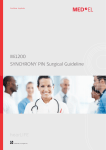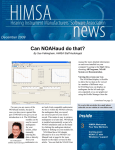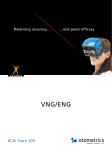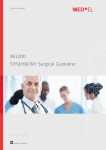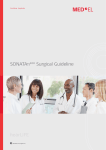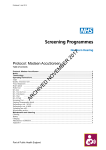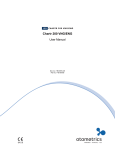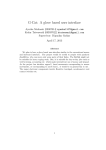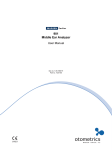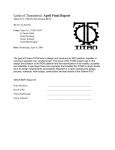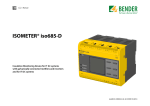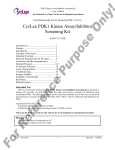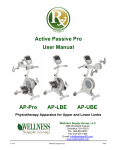Download Question Answer
Transcript
FAQ Question Why is ICS Impulse superior to Visual Observation? Answer • ICS Impulse can identify covert saccades • Validates that the head impulse is performed properly • Both sensitivity and specificity are 95% for ICS Impulse. Sensitivity is estimated at 70% for visual observation* • Reduction in false negative (identifying patients as normal who are truly abnormal) • Objective Analysis with normative data • Documented head impulse test results • Better patient comfort during testing because smaller head impulses can be used (150 -200 deg/s) with superior diagnostic accuracy. * Weber KP, Aw ST, Todd MJ, McGarvie LA, Curthoys IS, Halmagyi GM. Head impulse test in unilateral vestibular loss: vestibulo-ocular reflex and catch-up saccades. Neurology 2008; 70(6):454-463. How is Head Impulse testing similar and different from Caloric testing? HIT • Ear-specific • Detects in cases of peripheral vestibular loss in Lateral SCC – LARP/RALP in Anterior and Posterior SCC • Tests at High Frequencies (4-5 Hz) which is stimuli replicating the patient’s everyday situations • Stimulus does not persist between tests Caloric • Ear-specific • Detects in cases of peripheral vestibular loss in Lateral SCC • Tests at Low Frequencies (~0.025 Hz) • Stimulus can persist between irrigations especially if not performed properly Why is it important to calibrate each patient? Why should default calibration only be used if the patient cannot be properly calibrated? If possible you should always perform calibration. If the patient cannot see the laser calibration dots or cognitively cannot perform the task take the default calibration values. Remember, the patient has to be able to see the fixation dot or stare at something during the test. Default calibration values are 38 (left) and 59 (right). Based on 25 patients range 24-51 (left) and 42-73 (right). By using the default calibration, you could be introducing as much as 10% variability to the data collection results. This is why it is important to calibrate the patient if possible; however, this variability is better than not being able to test at all. Why is performing unpredictable head impulses important? Why do we not want the patient to be able to anticipate the head impulse? We do not want the patient to try to compensate for their disorder. Randomizing head impulse direction mainly affects the catch-up saccade pattern. If the head impulses are completely predictable, patients will do better in making covert saccades (compensating). In order to show the deficit (which is the purpose of the test), it’s better to randomize the order. Unless the catch-up saccades are very early (<100ms) they will not interfere with gain measurements. What is the best velocity to use during testing when trying to identify unilateral deficits reliably? 150-200 deg/s. The lower limit is based on the following publication (figure 2). Head impulse test in unilateral vestibular loss: vestibulo-ocular reflex and catch-up saccades. Weber KP, Aw ST, Todd MJ, McGarvie LA, Curthoys IS, Halmagyi GM. Neurology. 2008 Feb 5;70(6):454- 63. The upper limited was based on experience from the team in the article. The more vigorous the head impulse, the more likely you will get bumps & artifacts with a video goggle system. Why am I getting high gain values? High gain values could be one or a result of a combination of the below issues. 1) Slippage of the goggles - make sure strap is very snug, that the cable from the goggles is clipped to the patient’s right shoulder or collar with some slack, and there are not gaps between the foam cushion and the patient’s face. See section 3.4 of the user manual for pics of a good and poor goggle placement. You can access the manual from the bottom left corner of the software. 2) Patient is too close to the fixation dot - If they are closer than 1 meter you will see increased gains due to convergence of the eyes. VOR gains will go up with close distances. Never stand in front of the patient and have them fixate on your nose when using ICS Impulse. This method of testing will result in higher gains. 3) If you have ruled out 1 & 2, it could be that the patient has Meniere’s. See Manzari et al. Rapid fluctuations in dynamic semicircular canal function in early Meniere’s disease Eur Arch Otorhinolaryngol 14 Dec 2010. Why collect varying velocities? Recording of different velocities was interesting from a scientific point of view, because it told us that velocities of about 150-200 deg/s are necessary to detect a unilateral deficit reliably. The only reason for different velocities in clinics is that the 3D plots look much nicer. Why should the patient be 1 meter from the fixation dot? Having a very close target activates convergence, i.e. the eyes have to cross in order to look at the dot. Activation of the convergence system may interfere with the VOR. In addition, a close target adds a linear component, i.e. the eyes moves sideways relative to the dot (this effect becomes smaller with increasing distance of the target). From a technical point of view, there may be some parallax of the laser (relative movement of the laser dot in the field), because it is attached to the right side of the goggles. Therefore it is a good idea to have at least 1 m of distance. www.icsimpulse.com FAQ Answer What happens if the frame rate drops below 219? If the frame rate drops below 219 during data collection the software will alert the tester with a message on the collection screen. This does not stop data collection. A frame rate below 219 is problematic because the data collection will not be accurate (e.g. peak velocity, gain measurements etc). What is the difference between overt and covert catch-up saccades? • Overt – occur after the head movement and can sometimes be seen using visual observation • Covert – occur during the head movement and cannot be seen using visual observation Where did the default normative data cutoffs come from? MacDougal HG, Weber KP et al (2009) The video head impulse test: Diagnostic accuracy in peripheral vestibulopathy. Neurology 73:1134-1141. What is the difference between the collected and accepted data? These are 2 completely separate algorithms. The collected algorithm is on-line (during data collection) and less detailed. These are the numbers that display in the collection window (left/right accepts and rejects) and is displayed in the collected column in the test info window. All the data (not just the collected data) goes thru a second algorithm - the Analysis algorithm and this is more detailed and off-line and the results are displayed in the accepted column in the test info window and what is included in the 2D and 3D analysis. The numbers for the collected and accepted do not always add up to the same number because the raw data is being analyzed twice by 2 different algorithms. Can I export data in a format I can use for research? Yes, you can export patients and choose ASCII. How many head impulses should I perform? The default is 20. This was recommended by Drs. Halmagyi and Curthoys as a starting point. Once the tester is confident in their ability to perform proper head impulses with very few rejects then this number can be reduced. How large are the video files? Video files are approximately 4.3 MB per hour when recording ROI (region of interest) at 120 fps. Recording the video at a slower frame rate will create a smaller file. Using full image instead of ROI will create a larger file. To save disk space, always delete videos that are not needed. Can you test a patient that has Strabismus? Yes, as long as it’s not a paralytic strabismus. You need to cover one eye (the one that is not recorded) to make sure the patient is always fixating with the same eye. Gain vs 3D Tracing – What should I look at? BOTH! Do not only rely on the gain graph to determine if the patient is within normal limits or has an abnormal VOR response. You must look at the traces. It is easier to see catch-up saccades in the 3D analysis. If the gain is in the normal range but the 3D analysis clearly shows catch-up saccades then the patient is exhibiting an abnormal response. This is sometimes seen with patients where their covert saccades are right on top of the peak velocity of the head trace. See blog posts at www.headimpulse.com to learn more. We tested a patient with right vestibular neuritis but the gain was normal on the left side. Why is this? This is often seen and has been documented in published articles. The VOR gain to the healthy side does decrease a bit but the normal range is large so you don’t detect that decrease. In Manzari L, Burgess AM, MacDougall HG, Curthoys IS Objective verification of full recovery of dynamic vestibular function after superior vestibular neuritis. Laryngoscope; 2001: Rapid Communication. In this article a patient when in attack the VOR gain for the healthy side is ~0.8 (still in the normal range), but on recovery the VOR returned to ~1.0. Why are gains for head impulses to one side higher than to the other side? There can be many reasons for that. The gain of each side can be affected by factors affecting just that labyrinth. There will be natural variations. Another reason is since the data is recorded only from the right eye, it is slightly biased (gains are higher on the right than on the left). Ian Curthoys calculated the asymmetry ratio for 90 healthy subjects (data collected by Manzari with prototype and unpublished) and found that the difference was very small 2.7%. This difference was reported in coils (Prog Brain Res. 2008; 171:195-8. Inter-ocular differences of the horizontal vestibulo-ocular reflex during impulsive testing Weber KP, Aw ST, Todd MJ, McGarvie LA, Pratap S, Curthoys IS, Halmagyi GM. Department of Neurology, Royal Prince Alfred Hospital, Sydney, Australia. konrad.weber@ bluewin.ch). In coils the difference was reported at 15%. It is hypothesized that the slower velocity head impulses used with goggles results in a lower difference between leftward and rightward head impulses. This effect most likely arises from physiology. GN Otometrics, Europe. +45 45 75 55 55. [email protected] GN Otometrics, North America. 1-800-289-2150. [email protected] www.otometrics.com www.icsimpulse.com Specifications are subject to change without notice. Copyright © GN Otometrics. 2012/05. 7-26-8801-EN/02. Part no. 7-26-88001-EN. Question



